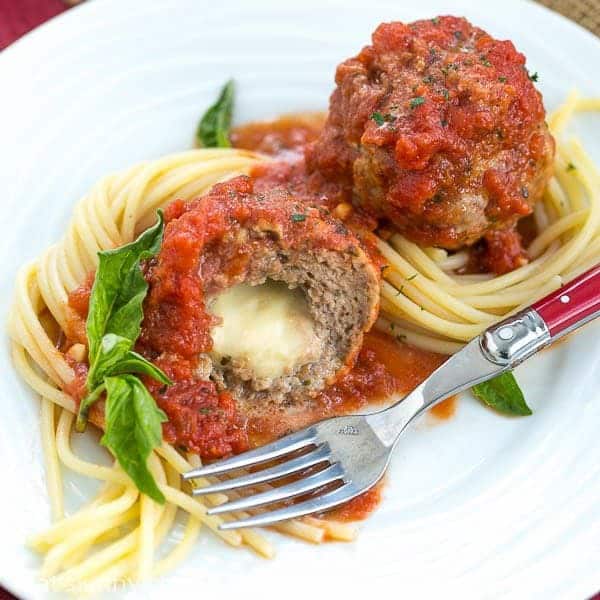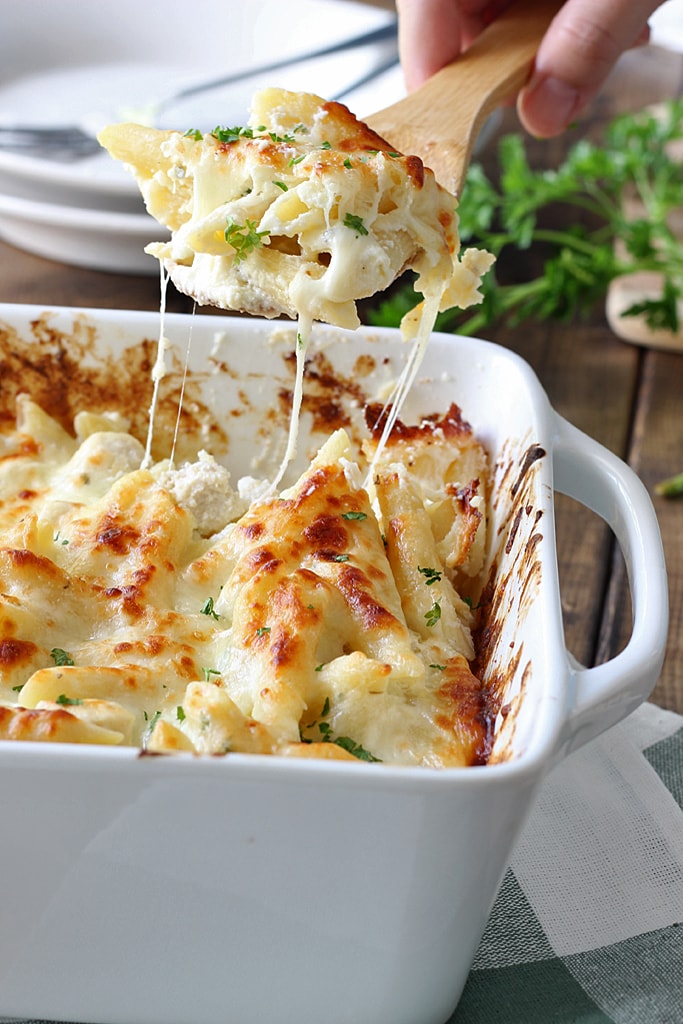Tag: Mozzarella
Mozzarella: Everything You Need to Know
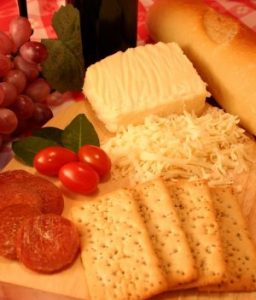
We continue our explanations of the world’s cheeses today with a look at delicious mozzarella. Whilst you probably eat this cheese fairly regularly, you might not know how it is made. Read on to find out all about the process as well as some creative ideas for using it in dishes at home.
What is Mozzarella Cheese?
Mozzarella is a semi-soft cheese. Due to its high moisture content, it is traditionally served the day after it is made, but can be kept in brine for up to a week or longer when sold in vacuum-sealed packages.
Derived from the Neapolitan dialect spoken in Campania, mozzarella is the diminutive form of mozza (“cut”) or mozzare (“to cut off”) derived from the method of working. The term is first mentioned in 1570, cited in a cookbook by Bartolomeo Scappi, reading “milk cream, fresh butter, ricotta cheese, fresh Mozzarella, and milk”.
How is it made?
Citric acid and milk are combined and then heated until the mixture is ready to have rennet added. At this point, the curds and whey will have separated and the curds will be cut. They are the removed, stretched and kneaded until the become the cheese that we recognize.
If you want to have a go at making this quick and simple cheese at home, we do have a recipe on the blog. It takes just 30 minutes!
How should I eat Mozzarella Cheese?
Of course, we have to start by recommending pizza. If you’ve never made it at home then give it a go. Pizza dough is really easy to make and if you get yourself a pizza stone you will be able to enjoy the crispy base you love without even leaving the house. Only use little mozzarella, to stop the dough from becoming soggy, and add your favorite toppings.
It is delicious in a Caprese salad with tomatoes. Simply layer slices of mozzarella, tomato, and basil leaves. Drizzle with a little extra virgin olive oil and season lightly with salt and pepper.
For a slight twist, try a fruity salad instead. It pairs well with figs, oranges, or even peaches as the creaminess of the cheese sits with the acidity of the fruit. Complement the sweet salad with the saltiness of ham or bacon and you’re sure to impress.
Put a small piece of mozzarella into the center of homemade burger patties and it will melt perfectly, creating a cheesy sauce as you cut into the burger.
We also offer a Smoked Mozzarella, which undergoes a steady treatment of hickory and cherry wood-smoke. The natural smokey flavor of this delightful cheese is great in casseroles, on sandwiches, or alone with a handful of crackers.
What should I drink with it?
The ideal wine pairing is a cold glass of Pinot Grigio. However, a rose wine such as a White Zinfandel or even a light red such as Beaujolais could also work well. If in doubt, choose an Italian wine to complement this Italian cheese.
How do you like to enjoy Mozzarella Cheese? Let us know in the comments below!
3 Uses for Mozzarella – Let’s Try Homemade Cheese Today!
As regular readers will know, we’re huge fans of sharing fantastic cheese recipes with you.
If you’re needing some fresh to pep up your January, there’s nothing better than our homemade mozzarella. It’s ready in just 30 minutes and you can make it at home. Even better, once you’ve made some delicious mozzarella, you get to eat it!
Mozzarella is a semi-soft cheese. Due to its high moisture content, it is traditionally served the day after it is made, but can be kept in brine for up to a week in the fridge.
Derived from the Neapolitan dialect spoken in Campania, mozzarella is the diminutive form of mozza (“cut”) or mozzare (“to cut off”) derived from the method of working. The term is first mentioned in 1570, cited in a cookbook by Bartolomeo Scappi, reading “milk cream, fresh butter, ricotta cheese, fresh Mozzarella, and milk”.
You probably already have some favorite mozzarella recipes, but we hope our ideas will inspire you to make some cheese today.

1. On a pizza
We know this isn’t a new idea, but if you’ve never made pizza at home then now is definitely the time to give it a go. Pizza dough is really easy to make and if you get yourself a pizza stone you will be able to enjoy the crispy base you love without even leaving the house.
You only need a little mozzarella, to stop the dough from becoming soggy, and then you add your favorite toppings. You could even put some mozzarella on the edges of the pizza and roll over the dough to make your own stuffed crust. Invite your friends over for a pizza party and they’re sure to marvel at your homemade cheese.
2. In a fruity salad
Whilst you might always think of having mozzarella in a Caprese salad with tomatoes, its creaminess is the perfect accompaniment to a salad with fruits.
Combine mozzarella with figs and green beans, oranges and arugula, or peaches and basil for a great pick-me-up salad. All of these will go perfectly with ham or bacon. Get creative and try your own combinations, too.
3. In a burger
No, we don’t mean in a bun with your burger, we actually mean in a burger. This is another recipe to try at home if you’ve never had a go before. Patties can be made simply out of ground beef, bread crumbs, an egg and salt and pepper. But next time you make them, roll a small piece of mozzarella into the middle. When they cook, the cheese will melt inside and will ooze deliciousness with every bite.
Make sure to fill your bun with your favorite salad and relishes for real perfection.
If you’re looking for a wine pairing for mozzarella, a fruity Sauvignon Blanc will work perfectly with the mild freshness of the cheese. If you prefer red wine, the cherry flavors of Sangiovese or Chianti would work well.
Let us know what you make in the comments! We’d love to hear your ideas for using mozzarella.
How To Make Mozzarella In 30 Minutes
Recipe
A few things to note before making this recipe:
– Make sure the milk you use is not ultra pasteurized
– You can use homogenized or non-homogenized milk
– Farm fresh milk is a great option if you can find it locally
– Low-fat milk will work but the cheese will be drier and less flavorful

What You Need
1 Gallon of Milk (Not UltraPasteurized)
1 1/2 Tsp Citric Acid
1/4 Rennet Tablet or 1/4 tsp Single Strength Liquid Rennet
Cheese Salt
What To Do
1. Start by preparing your work area, make sure that you are not preparing other food while making this cheese.
Be sure to have a clean work area, moving everything away and sanitizing your counter, stove and sink with soap and water. Use an antibacterial cleaner to wipe down all surfaces.
2. Now is time to prepare the rennet. Crush a 1/4 tablet of rennet and dissolve in a 1/4 cup of cool un-chlorinated water or add 1/4 Tsp of single strength liquid rennet to the water. Then, set your mixture aside to use for later.
3. Mix 1 1/2 Tsp of citric acid, to a cup of cool water and add it to your pot.
Then pour cold milk into your pot quickly to mix well with the citric acid. This will make sure the milk is at a proper acidity to stretch it well later.
4. Now heat the milk slowly to 90F. You will notice that your milk is beginning to curdle slightly when it starts to come close to 90F, this is because of the acidity and temperature.
You may need to increase the temperature to 95F or even 100F if the milk is having problems with forming a proper curd.
5. Once your temperature is at 90F, remove your pot from the stove and slowly add your rennet to the milk. Stir it for 30 seconds in a top to bottom motion and then stop.
Now cover the pot and leave undisturbed for 5 minutes.
After 5 minutes, check the curd. It should look like custard with a clear separation between the curds and the whey. Let the curd sit for a few more minutes if it is too soft or the whey is a cloudy appearance.
6. Begin cutting the curds into a 1-inch checkerboard pattern.
Now place the pot back on the stove and heat the curd back to 105F while slowly stirring the curds with a ladle. Once at 105F, take the pot off the burner and continue to stir it slowly for 2-5 minutes.
7. Scoop the curds into a colander with a slotted spoon. If the curds appear too soft, let it sit for another minute or so.
Once you have transferred the curd, press the curd gently with your hand, pouring off as much whey as you can. If you wish, you can keep the whey for later use in baking or cooking.
8. Transfer the curds to a heat safe bowl and microwave the curd for 1 minute.
There will be noticeable whey separation from the curd, so drain off all the whey as you did before. Work the cheese with a spoon or your hands until it is cool enough to touch.
Microwave it two more times for 35 seconds each, and repeat the kneading as in the last step to aid in more whey drain off and ensure even heating of the curds. Drain off all of the whey as you go.
9. Now to begin stretching and kneading the curd. Start by quickly kneading the bread dough. Remove the curd from the bowl and continue kneading it until it is smooth and shiny. If needed, return it to the microwave if it begins to cool off before it is ready to stretch. Near finishing time, add salt. The cheese should be soft enough to stretch and stretch however you desire. This is what makes it Mozzarella after all.
10. In this step, knead your cheese back into a big ball until it is smooth and shiny. Now your Mozzarella will be ready as soon as it’s cool enough to eat. If you want to cool it quickly, place it into a bowl of ice water and refrigerate it.
The Best Ways To Each Cheese: Part 1
Who doesn’t like eating cheese? As a culture with a strong, burning passion for food, at or near the top of this list, we often find cheese. Cheese is an overlooked, and often underappreciated food. In can be integrated into countless dishes, or it can be used as a topper for so many more dishes, salads and even desserts. We, as a civilization, never seem to run out of ideas for our uses of cheese. Every day, it seems that culinary experts and chefs around the world are experimenting with different cheeses and dishes in their efforts to create new dishes whose main attraction is cheese, in some way, shape or form.
Let’s taker a gander at some of the more ingenious creations in which cheese is used, or hidden, for that matter. Now, keep in mind, some of these dishes or cheese concealments require a “think outside of the box” approach…
Cheese-stuffed Meatballs
When making meatballs, add some “umpf” to it by integrated some of your favorite cheese when rolling the meat to form meatballs. As the cheese meets the heat when cooking, the cheese will expand and will add an extraordinary flavor to an already delicious meatball.
___________________________________________________________
Ham, Egg and Cheese Crepe
- Make your pancake, as you normally would… the thinner, the better in the case of this recipe.
- When the underside is nearly cooked, place a slice of ham on top, topped off with some of your favorite cheese.
- Fold the sides into to make a square, or as close as you can get to one.
- Break your egg into the space left… leave sunny-side up.
- Squish the sides down with your spatula to seal as the cheese melts.
- Cook for 3 or 4 minutes until the egg is turning white.
- Pop under the grill for a further 2 or 3 minutes until the yolk is just starting to cook, or however you like it. (Although, if you like it any way other than runny you’re way crazy.)
Source: http://www.tamingtwins.com/ham-egg-and-cheese-crepes/
____________________________________________________________
A Cheesy Pie Crust… literally
Making a pie crust with cheddar cheese baked directly into the crust gives it an entirely new dimension of flavor. Try baking an Apple Pie with a cheddar cheese infused crust. Goodness, that sounds absolutely amazing just thinking about it.
_____________________________________________________________
For the Gluten-Free
For those who are in search of gluten-free foods, try using cheese as bread crumbs over zucchini. If this peaks your interest, try this recipe for starters… Parmesan Baked Zucchini.
INGREDIENTS:
- 4 zucchini, quartered lengthwise
- 1/2 cup freshly grated Parmesan
- 1/2 teaspoon dried Thyme
- 1/2 teaspoon dried Oregano
- 1/2 teaspoon dried Basil
- 1/4 teaspoon Garlic Powder
- Kosher salt and freshly ground black pepper, to taste
- 2 tablespoons Olive Oil
- 2 tablespoon chopped fresh Parsley leaves
DIRECTIONS:
- Preheat oven to 350°F. Coat a cooling rack with a nonstick spray such as Crisco and place on a baking sheet.
- In a bowl, combine the following: Parmesan, Thyme, Oregano, Basil, Garlic Powder, salt and pepper. Taste to determine if this meets desired taste.
- Place the quartered zucchini onto prepared baking sheet. Sprinkle olive oil and as well as Parmesan mixture.
- Place into oven and bake until tender. This usually takes ~ 15 minutes. Then broil for around 2-3 minutes, or until crisp and golden brown.
- Serve immediately. Garnished if that is your thing…
Source: http://damndelicious.net/2014/06/21/baked-parmesan-zucchini/
___________________________________________________________
Cheese-Infused Loaf of Bread
This is quite the old-fashioned move, but as they say, “an oldie but goodie” and this no doubt falls in this league. When baking a loaf of bread, step up your culinary game and inject a concoction into the center of the bread; a concoction of your favorite cheese, spices, herbs, etc. Bake and enjoy!
____________________________________________________________
More Cheese… More Bread
With the Cheese-Infused Bread in the back of your mind, try this cheese creation on for size. The Bread Bowl of Cheese is another cheese creation, or should I say, masterpiece, that is in yet another league of its own. Try this recipe…
INGREDIENTS
- 4 bread rolls (soft or crusty)
- 4 small slices of ham, or 2 big ones cut in half
- 4 eggs, at room temperature
- ½ cup shredded mozzarella cheese
- 1 tbsp fresh parsley, finely chopped (optional)
INSTRUCTIONS
- Preheat oven to 350°F.
- Cut tops off the bread rolls.
- Scoop out the center of each bread roll and reserve. Although this can be quite an intricate step in the overall recipe, try to keep your cuts and scoops nice and neat.
- Line the bread bowl with a layer of ham, using a single slice or multiple slices as needed.
- Crack in an egg. This is the part of the recipe where Humpty Dumpty came to mind with me.
- Top each with 2 tablespoons of Mozzarella and a sprinkle of parsley, if desired.
- Put the tops back on each roll. Wrap with foil and place in oven to bake for ~10 to 15 minutes, making certain to check periodically, ideally, in 10 minute intervals.
- 10 minutes = very runny yolks. 15 minutes = firm just cooked yolks. 15 minutes + = very cooked yolks.
- Remove from oven, unwrap, serve immediately and enjoy heaven in a bowl.
What is the Perfect Cheese For Pizza?
September 5th marked a day of celebration for America, and perhaps, even much of the world… because who doesn’t like pizza and cheese or both? Unknown to many is that September 5th is National Cheese Pizza Day. You know with the birth of smartphones and mobile apps came the phrase “…there’s an app for that”, well in similar light, if you love a food or, in this case, a combination of foods, a new axiom may take shape here, “…there might just be ‘National’ day for that”. A day that puts the focus of pizza and cheese, two delicious foods in and of themselves, but when together, spark a whole new revelation of culinary marvel… who would not love a day just to celebrate such a marvel? The answer should be simple… no one.
There has been an age-old question that continues to make the mind wonder and wander, that is… “Is there a perfect cheese to put on pizza?” Dr. Bryony James, a scientist whose research centers on food microstructure and food material science in New Zealand at the University of Auckland dove right in to find an answer the this question. Dr. James’ team of scientists study the building blocks of food and even experiment with structural composition of various foods that can influence its functionality. Ideally, their line of scientific research would allow them to develop a potential hypothesis for such an experiment. As the team began initial studies of the “best cheese for pizza”, they already knew that, historically, Mozzarella was highly favored and the most commonly used cheese for pizza topping.
Among countless scientific trials and experiments, the team researched cheese based on browning and blistering. These variable were designated as focuses of research as they were found to be the most looked upon features by consumers. Examining the properties, features and characteristics of cheese could potentially lead to further discoveries of the ideal cheese or in some cases, the ideal combination of cheeses to use on pizza. Other cheeses the group extended their research to was Cheddar, Colby, Emmental, Gruyere and Provolone. The actual experimentation itself was conducted by state-of-the-art technology, as opposed to human hands. As human judgment would have been idea over the work of a machine, it would have been far more time-consuming and brought the idea of a “bias” trial or opinions when bringing human emotion and interaction into the picture.
Of the properties of cheese that were measured for this experiment, smell, texture, melting properties and color were at the forefront. Researched revealed that some cheeses like Cheddar did not produce a favorable level of blistering while the likes of Gruyere did not properly brown after melting, which can be attributed to the oil content within the cheese. The results clearly indicated that although Mozzarella might be the traditional favorite cheese topper for pizzas, there might not be that “perfect” cheese or combination of cheeses, as each cheese’s characteristics and properties, when undergoing melting, might be desirable for one consumer, but desirable for another.
Source: http://www.cheeserank.com/post/the-science-of-pizza-cheese
Mozzarella: The Papa Of Fresh Cheese!
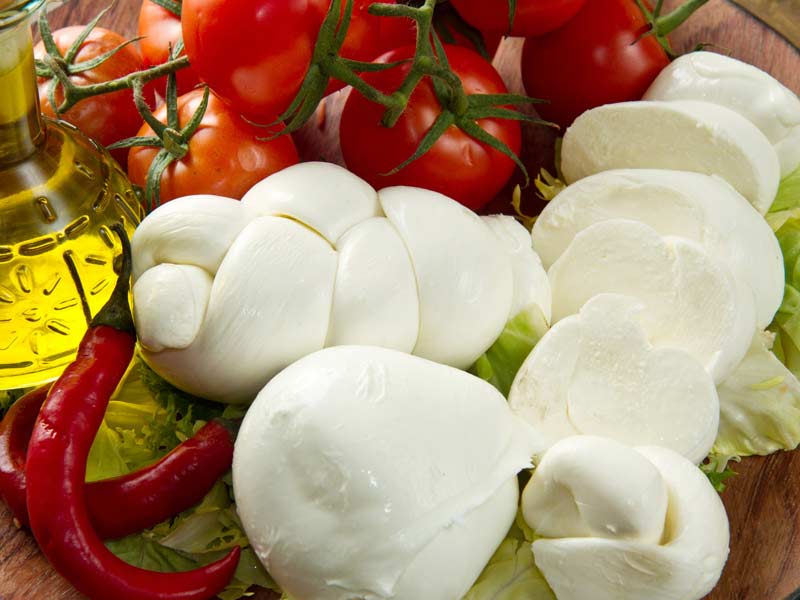
Mozzarella is a very famous fresh cheese, made from goat’s milk, cow’s milk or in some cases, buffalo’s milk by means of an intricate and complex process by the name of “pasta filata method”. Originally from southern Italy, its name is quiet common for many different types of Italian cheeses made using “spinning” and then “cutting” this original pasta coming from milk : The Italian verb “mozzare” means exactly “to cut”.
Some common and famous types are:
- Buffalo mozzarella made from domesticated buffalo milk;
- Mozzarella fior di latte (or simply Fiordilatte) is made from fresh pasteurized, or also unpasteurized, cow’s milk:
- Low-moisture mozzarella, which is made from whole or part skimmed milk, and widely used in the food-service industry;
- Smoked mozzarella (affumicata) called in this way for the treatment that is receives which gives it a very particular and special smell and taste;
Fresh mozzarella is usually white in its common visual expression, but this colour can vary seasonally to a very mild yellow depending on the specific diet with which the animal is fed. It is a semi-soft cheese and traditionally served the day after the production, but can be kept “in brine” for a week or even more if sold in vacuum-sealed packages. Low-moisture mozzarella can also be kept refrigerated for up to a month. It is also used for many types of pizza and many very famous and tasty pasta dishes (Cooking Mozzarella) but it can be also served with slices of tomatoes and basil in the very typical “insalata caprese”.
History
A bufala is a female water buffalo. Hers is the milk – rare and expensive – from which mozzarella is traditionally made. These days, however, you’re more likely to find a version made from cows’ milk, which is more readily available and much less costly.
The history of mozzarella is closely linked to that of the water buffalo. How and when did the animals arrive in Italy? Some say it was Hannibal, others talk about Arab invasions and still others say that India was the source. What we do know is that they began to be raised in the 12th century, at a time when many peasants, fleeing war and invasions, abandoned their land. That land turned marshy, which is exactly what water buffalo like. Several centuries later, northern Italy became concerned about cleaning up the marshlands, and in 1930, the south began a massive agrarian reform. The herds of water buffalo, the “black mine” that produced “white gold,” dwindled. Cow’s milk began to replace bufala milk in the recipe. Then, in 1940 the Nazis destroyed the remaining herds. After the war, water buffalo imported from India were reintroduced to Italy, but the cheese introduced to North America by Italian immigrants in New York at the turn of the 20th century and in Canada around 1949 was made with cow’s milk.
Aside from the milk, mozzarella’s other distinguishing feature is its stringy texture. After the whey is discarded, the curds are “strung” or “spun” to achieve the characteristic pasta filata. The cheese is then cut (in Italian, mozzare means to cut), immersed in water to firm it up, then covered in a light brine, in which it is kept until it is eaten.
Etymology of the name
The name was mentioned in a cookbook witten by Bartolomeo Scappi in the 1570: “milk cream, fresh butter, ricotta cheese, fresh mozzarella and milk” (…).
The name comes from the Neapolitan dialect (from Naples, the capital of Campania) and it is the diminutive of “mozza” which, as we saw, means “cut” or, if you want from the verb “mozzare” (to cut) and it rappresents the technique of working the pasta coming from milk.
A very similar cheese is “Scamorza” which probably derives from scamozzata which leterally means “without a shirt”, reffered to the appearance of these cheeses “without” hard surface covering typical of many other dry cheeses.
Types
“Mozzarella di bufala campana” as mentioned before is a specific quality made from the buffalo’s milk: these are raised in specific areas of the territory of the regions of Lazio and Campania (Italy).
Unlike other types, that can derive from non-Italian milk and often semi-coagulated milk, the buffalo mozzarella holds the status of “Denominazione di Origine Protetta” (protected designation of origin – PDO 1996) under the European Union, While in 1996 mozzarella was recognized as a Specialità Tradizionale Garantita (STG) which translated means “Traditional Speciality Guaranteed”.
Fior di latte or simply Fiordilatte is a mozzarella made only from cow’s milk (not from buffalo). The quality of this product is inferior compared to the one from buffalo and as consequence also the price of this type of mozzarella is lower. It is for this reason that is always important the certification of the label because, especially abroad it is not unusual to find “mozzarella” not clearly labeled as deriving from buffalo made instead from cow’s milk.
Composition
You can find two type of Mozzarella: fresh or partly dried.
- The fresh one is usually shaped into balls that weigh 80-100 grams, for a diameter that usually is not more than 5- 6 centimetres. Specific brands can nevertheless make balls that can reach 1 kilogram for or about 10-12 centimetres in diameter. This fresh version is usually soaked in salt water (brine) or whey, rarely with the addition of citric acid;
- The partly dried mozzarella is more compact and dense, usually used to prepare dishes cooked in the oven, such as “pasta al forno”, pizza, etc.
It is possible to twist the “pasta filante” with the result that the final shape is a plait: this type of mozzarella is called “Treccia”. and it can have many length according to the final destination: Sunday 13 of June 2006 after 6 hours of work, Avellino won the Guinness World Record with the longest Mozzarella Treccia in the world – 106,16 meters. But usually the dimension is from few centimeters to few decimeters.
An other interesting and very typical type is the so called “Mozzarella affumicata” which is a is smoked varietes, very tasty and with a light brown collor due to the smoke that is on the surfice of the cheese.
“Nodini” is an other type of mozzarella: the term means little knots and in fact he shapes is made by weaving once the “pasta filante” and the dimension is typically around 3-4 cm. Similar to bocconcini, but a unique knot shape, this cheese gives a nicer texture and ability to expose more surface with about the same volume.
“Mozzarella Sfoglia” , literally “mozzarella sheet” is a cheese inspired by traditional puff pastry; especially in Puglia, it is the traditional base for the preparation of sweet and savoury recipes, stuffed to create original hot and cold dishes.
Several variants of mozzarella are specifically formulated for pizza: “Cooking Mozzarella” is a low-moisture Mozzarella cheese: as you can understand it contains less water than real one”.
Mozzarella can be shaped in very particular ways and artistic shapes such as elephant, pig, dummy, which are widely produced in Southern Italy: the aim of this idea is to distract where possible kids from eating junk food/candies and so for snacks and focusing on high calcium and healthy cheese instead but keeping the fun and interest high.
“Burrata” meaning “buttered”: it is a dreamy fresh cheese that consists of a Mozzarella pouch, rather than a ball, filled with a delicate milky-mousse. When you bite into it, the fillinggently oozes out. Delicious!
Stop into Shisler’s Cheese House and pick up some of your own Mozzarella!
Chicken Alfredo Pasta Bake: For the Cheese and Pasta Lover
CHICKEN ALFREDO PASTA BAKE
I don’t know about you, but I love a good Alfredo. It’s rich, it’s oh so yummy. And why shouldn’t we love it? It has all the goodness of butter, cream and Parmesan. Creamy. Cheesy. Yummy. So today we’re taking good old Alfredo sauce and making a chicken pasta bake. And we’ll add more cheese plus other stuff to make a great summer pasta casserole.
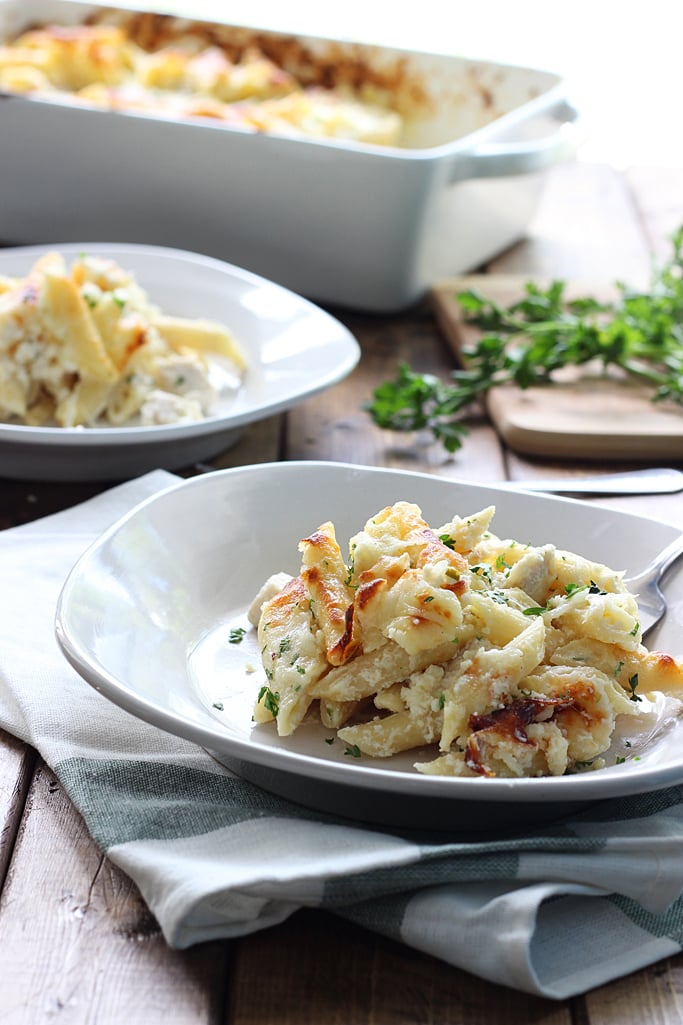
So if you’re wanting cheese, this is your dish! This makes a huge serving to go around and it heats up well. It’ll make that wet squishy sound when you mix it all up, a sign of tons of creamy cheesy power. It’ll give you long strands of cheese when you dish a serving. The kind that you’ll want to run your finger along to break. And it’ll more than satisfy your cheese craving.
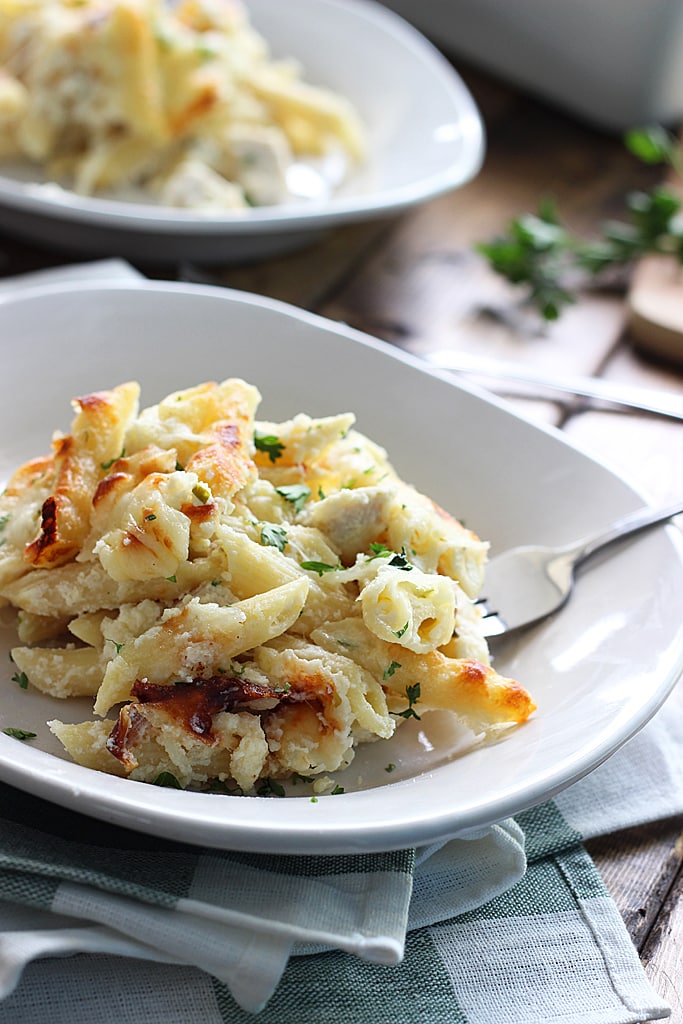
The great thing about this is how you can customize it to save you time. The best Alfredo sauce from scratch but you can use store-bought sauce. If you don’t like poached chicken, grill it. Or buy some rotisserie chicken and chop it up. And you can practically use any kind of pasta you want. Generally, penne is deal for bakes but there’s ziti and rigatoni.
Make sure to cook the pasta until the point just before it turns al dente. Then rinse it under cold water to stop the cooking process. Because if it continues cooking in the cheese sauce in the oven, it’ll get slightly mushy and mushy pasta is no fun…. to avoid this, finish off the al dente process in the oven. However, if you don’t mind or even like mushy pasta, then keep on cooking that pasta until it’s al dente, your choice…
There’s a lot of ricotta to go around, as you can see. So if you’re not big on it, you can halve the ricotta and egg portion before mixing it in with everything. Some people like it, some people don’t, again, your choice…
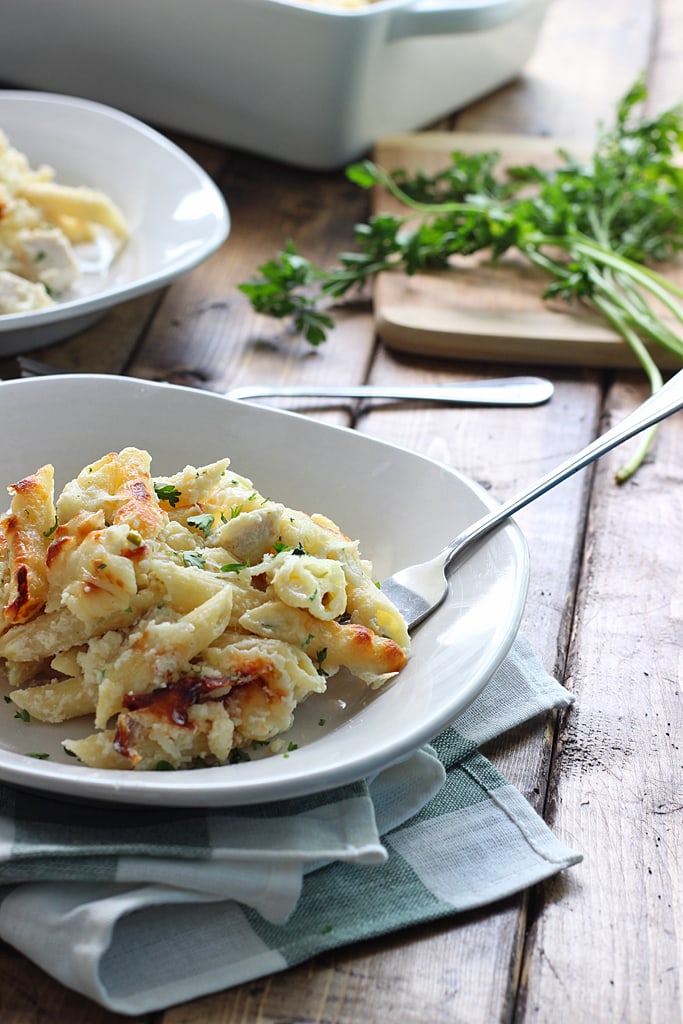
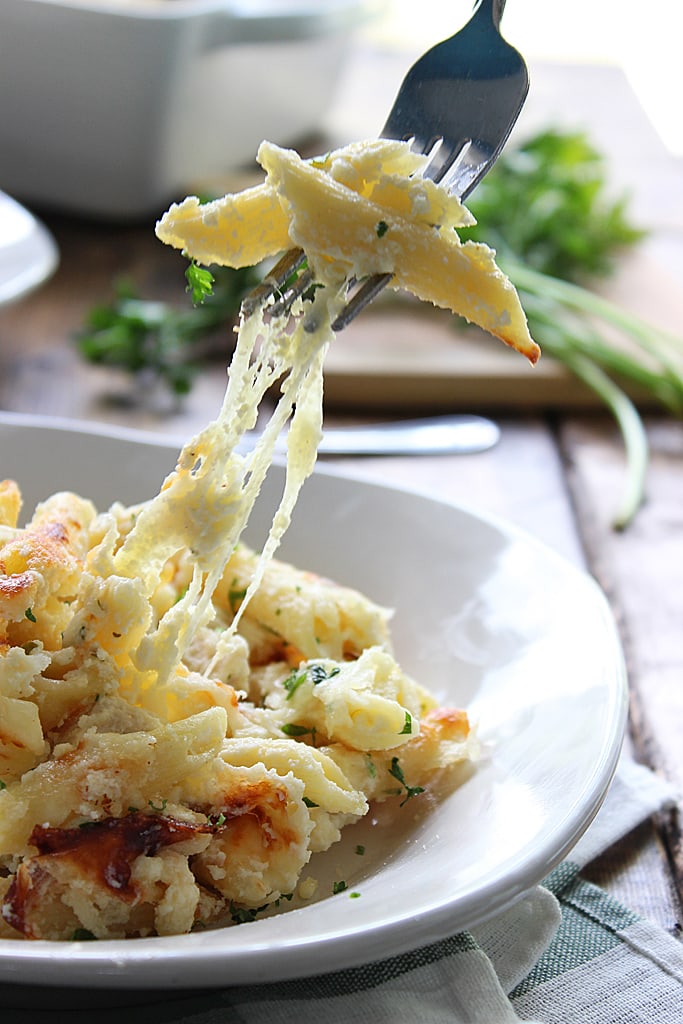
So really, if you’re looking for a fairly quick, but delicious meal idea for lunch or dinner, this one’s for you, as the amount of time it takes from start to eat is just under and hour…. not bad at all… Or if you’re a family of four and you want something for two days, here you go. And if you have a huge family, have at it. This can serve up to ten servings. The cheese is not stingy!
- 16 oz. penne/ziti/rigatoni pasta
- 2 cups Alfredo sauce
- 8 oz. sour cream
- 3 cups poached/grilled/rotisserie chicken, cubed
- 15 oz. ricotta cheese
- 1 teaspoon garlic, minced
- 2 eggs, beaten
- ¼ cup Parmesan cheese, shredded
- 1 tablespoon parsley, chopped
- Salt and pepper to taste
- 2 cups mozzarella cheese, shredded
- Cook the pasta till just before al dente
- Drain and rinse pasta under cold water to stop the cooking process
- If you’re making Alfredo sauce from scratch, see notes
- Mix pasta with the Alfredo sauce, sour cream and chicken
- Combine ricotta, garlic, eggs, Parmesan and parsley and mix throughly
- Season the pasta mix with salt and pepper to taste
- Add the ricotta mixture to the pasta and stir to combine
- Top with a thick layer of mozzarella cheese
- Bake in a 9×13 casserole dish at 350 degrees F for 30 minutes or until bubbly
- Broil at 450 degrees F for 2-3 minutes or until the cheese starts to brown
- Serve hot
Insalata Caprese: Simple, Elegant, Refreshing, Delicious
INSALATA CAPRESE: THE ENDURING STYLE OF ITALIAN CUISINE

No one can quite say when or where the most famously simple of all salads — the insalata caprese — first appeared on the scene, or the exact origin of when it was named after that beautiful sun-soaked isle of Capri, part of very historic Campania region. But one thing we do know is that it is absolutely one of the most enduring of all Italian antipasti and so evocative of those heady days of fun, vino and romance along the Mediterranean coast. (Speaking of fabulous Italian things, be sure to check out the recent post Studio of Style did on Campari.) Of course, the famed tricolor look of the dish which, like the equally famed Margherita pizza of Napoli, depict the colors of the Italian flag. But let’s dig a little bit deeper into history, okay? (We know how you regular readers of Studio of Style just love a little bit more of everything, right?) First of all, so much of the world associates Italian cuisine with that wonderful deep red tomato sauce found on many dishes — but wait! The word “pomodoro” from the words “pomo d’oro” or “golden apple” doesn’t quite match up with the color red, now does it? That’s because the first tomatoes brought to Europe from the New World (i.e. The Americas) were actually more likely to have been yellow than red! More on that in a moment. But some say that “pomo d’oro” might also be a mistranslation of the phrase “pomo di moro” or “fruit of the Moors” who had introduced so many exotic foods to Italy. You see, it was Italian physician and botanist Pietro Andrea Mattioli who wrote in 1544 that a new type of eggplant had been brought to Italy which was blood red or golden in color that could be eaten like an eggplant — and 10 years later Mattioli used the words “pomo d’oro” in print. The yellow variety of the tomato definitely made landfall in Europe sometime after 1521 when Spanish conquistador Hernán Cortés captured the Aztec capital of Tenochtítlan in Mexico — though Christopher Columbus of Genoa (who was also working on behalf of the Spanish monarchy) might very well have brought some back around 1493! And did you know that the earliest known Italian cookbook with tomato recipes was published in Naples (naturally!) around 1692 — most likely the recipes were translated from Spanish sources. Thus, by a slight twist of history the famed marinara sauces became red and not yellow (but the name “golden apple” still stuck!). But the bigger question is: who put together that amazing combination of basil, mozzarella di bufala, tomatoes and olive oil — crowned with a light sprinkling of salt and black pepper — a combo that epicureans have been raving about ever since? To enjoy this antipasto to the fullest, try to find the freshest handmade mozzarella, the ripest seasonal tomatoes, absolutely fresh basil, the best extra virgin olive oil and high quality salt and freshly ground black pepper (and please, novinegar of any kind!!). Said perhaps one of the most famous Italians of all history, Leonardo da Vinci: “Simplicity is the ultimate sophistication.” And how right he was…and still is! The simple yet profound pleasures found in insalata caprese transcend time itself! And in the words of so many Italians throughout the ages: Mangia bene, vivi felice!
Once again, you can see the colors of the italian flag in this dish. Insalata Caprese is one of my all time favorite salads. I like to serve it over a bed of fresh spinach. Refreshing and light!
The word mozzarella comes from the italian verb “mozzare” which means to cut. Mozzarella di bufala is made from the milk of the domestic water buffalo, a bovine which has it origins in Asia but is now found in southern Europe, South America, Northern Africa and India among others. Mozzarella di bufala is a bit saltier and softer than regular cow’s milk mozzarella. The best quality is considered by many Mozzarella di Bufala di Campania made in the geographical areas of Lazio (near Rome) and Campania (Naples, Salerno, Paestum, Pompeii, including Capri) Regions which became protected by the European Union under Denominazione di Origine Controllata (DOC like in wines) in the 1990’s. It literally melts in your mouth! In short, mozzarella is made by heating the milk (to separate the whey form the curds), resting, spinning and pulling the cheese curds to shape into balls. The cheese maker will knead the curds like bread by hand, pull-out and cut the mozzarella balls once the cheese curds have reached the desired consistency. This is a semisoft cheese and has a high moisture content. That is why it is sold in specialty food shops in brine and vacuum sealed. On the other hand, good quality mozzarella di bufala is made in many other countries in Europe and the Americas.
Insalata Caprese (salad made in the style of Capri) can also be called Tricolore Salad which also includes avocado. If you want to splurge (it is more expensive than regular mozzarella) and the best flavor and quality, use mozzarella di bufala when you make homemade pizza. Use it as a topping or make Insalata Caprese Pizza. It is amazing!
Buon Appetito!
Instructions on making Insalata Caprese…
Ingredients
2 7 ounce mozzarella di bufala balls
2-3 Roma tomatoes
2 tbsp fresh basil coarsely chopped
1/2 tsp kosher salt
1/4 cup extra virgin olive oil
Pepper to taste
Drizzle of good quality aged balsamic vinegar (optional)
Procedure
1. Slice mozzarella and tomatoes. In a plate, alternate placing one slice of tomato over each slice of mozzarella.

2. In a small bowl, place the chopped basil with olive oil, salt and pepper and stir with a spoon.
3. Spoon mixture over mozzarella and tomatoes. Drizzle with balsamic vinegar and serve.
4. Enjoy this delicious and healthy dish!
Make sure to stop by Shisler’s Cheese House and let us help you create this simply, beautiful and delicious work of culinary art with our supply of fresh Mozzarella Cheese!
Marinate Cheese? Did Heaven’s Gates Open?
Summertime is all about easy entertaining and easier food: bountiful produce allows us to spend less time fussing in the kitchen and more time al fresco with friends. I’m all about quick recipes that produce big flavor, and these marinated mozzarella balls do just that. The best part? They get better the longer they sit, so make a triple batch and you’ll always be ready for unannounced guests that come your way.

Italians perfected the art of eating centuries ago, and one of many things they’ve mastered is the way to start a party. Antipasti — which means “before the meal” — are small bites meant to whet the appetite and prepare you for the upcoming feast. An antipasti platter can be composed of almost anything, but cured meats, cheeses, vegetables, and preserved pantry goods are the traditional place to start.
Antipasti, or any summer appetizer for that matter, can and should be as low maintenance as you desire. These “little mouthfuls” of mozzarella are marinated in a zesty bath of garlic, herbs, and olive oil. They are impressive enough to serve alone, but are right at home in a more expansive spread. Even better, they require minimal prep and can be adapted to whatever ingredients you already have on hand.
Don’t just keep this versatile recipe locked up at home. Transfer the tasty bites into cute jars to offer as hostess gifts, or pack them along on your next beach picnic. They’ll taste good anywhere you choose to eat them — even better with a bottle of chilled Rosé!

Garlic and Herb Marinated Mozzarella
1 pound (16 ounces) bocconcini or ciliegine, drained (See Recipe Notes)
Recipe Note
Bocconcini (and ciliegine) are 1- to 2-inch balls of fresh mozzarella packed in water. They can be found in gourmet cheese section of well-stocked grocery stores. Feel free to substitute feta or goat cheese if desired
Be sure to stop by Shisler’s Cheese House for your fresh supply of Mozzarella and get the marinating party started! Or order online here!
The Cheese Report Card: A Guide to the Best Cheeses
Though high in saturated fats, it provides many essential nutrients including protein, vitamin D and zinc as well as calcium.
Here’s a round-up of your favourite cheeses and how healthy they are. All figures are based on a healthy portion size of 30 grams (a matchbox-size chunk).
- Swiss
120 calories, 9 g fat, 290 mg calciumVery high protein, with a matching high-mineral content. A 30g portion of Emmenthal provides more than a third of the Recommended Daily Allowance (RDA) of calcium and nearly a tenth of the RDA for zinc – essential for healthy skin, reproductive health and the immune system.Health score: 8/10

Brie
96 calories, 8 g fat, 162 mg calciumMost people assume it is one of the fattiest cheeses, but it has lower levels than cheddar or stilton and a good quantity of calcium. It is also a reasonable source of zinc and the rind is rich in vitamin B1 – essential for cells to release energy.
Health score: 6/10
Camembert
89 calories, 7 g fat, 105 mg calcium
Camembert has a third less fat and a quarter fewer calories than hard cheeses. It is high in folic acid which the body needs to make red blood cells, though pregnant women (who need a higher intake of folic acid) should avoid Camembert.
Health score: 5/10
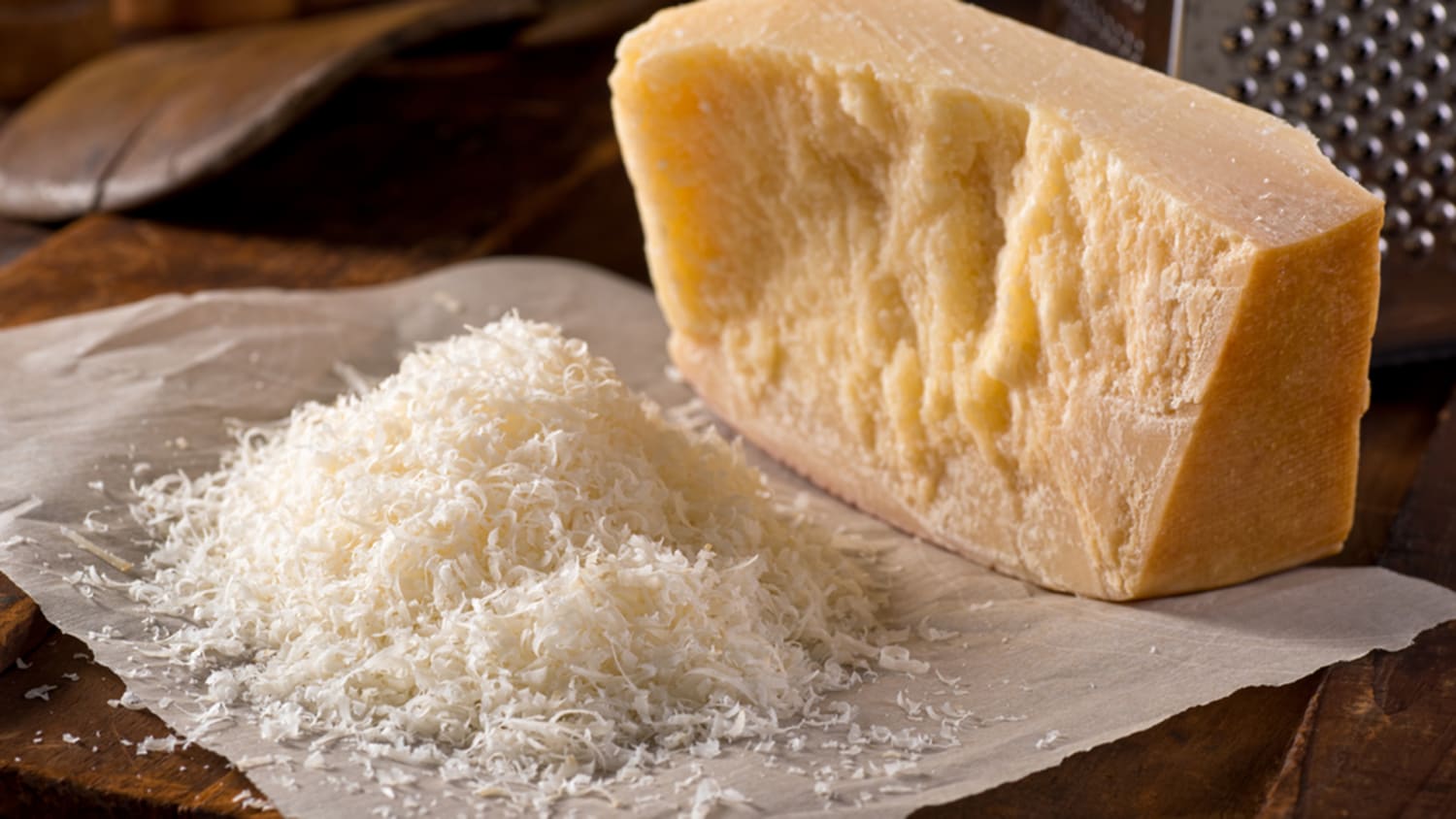
Parmesan
136 calories, 9.8 g fat, 360 mg calcium
Extremely high in calcium, just a tablespoon of Parmesan grated over pasta supplies 15 per cent of the RDA. It is also the best cheese for zinc, although it is high in salt.Health score: 9/10
Cottage Cheese
29 calories, 1.2 g fat, 22 mg calcium
This is the only truly low-fat cheese, making it ideal for slimmers. But the downside is a low calcium content, which reduces its nutritional rating compared with other cheeses.
Health score: 5/10
.jpg)
Cheddar
124 calories, 10.3 g fat, 216 mg calcium
One of the highest-fat cheeses, but it’s also a good source of calcium and zinc. A national favourite, nonetheless.Health score: 6/10
Half-fat cheddar
78 calories, 4.5 g fat, 252 mg calcium
Also higher in protein, calcium and zinc than normal cheddar. But on the downside, it’s a bit lower in vitamins A and D.Health score: 9/10
Cream cheese
132 calories, 14.2 g fat, 29 mg calcium
The unhealthiest cheese as it is close to 50 per cent pure fat and has only a fraction of the calcium content of many hard cheeses.
Health score: 2/10
Edam
100 calories, 7.6 g fat, 231 mg calcium
Contains a medium amount of fat, is rich in calcium, but high in salt so is not advisable for high blood pressure sufferers.
Health score: 8/10

Goat’s cheese
59 calories, 4.7 g fat, 57 mg calcium
Low in calories and richer in vitamin D (an important bone-strengthener) compared with cow’s milk cheeses, although it is not a great source of calcium or zinc.
Health score: 6/10
Processed cheese slices
78 calories, 5.6 g fat, 213 mg calcium
Rich in calcium and lower in unhealthy saturated fats than unprocessed cheese. Gets its dubious ‘plastic appeal’ from added milk proteins, modified starch, preservatives and emulsifiers.
Health score: 6/10Feta
75 calories, 6 g fat, 108 mg calcium
Made with sheep’s milk, it has a moderate amount of calcium and fewer calories than half-fat cheddar. Feta is also a better source of vitamin D than cow’s milk cheese, but is also the saltiest variety – a 30g portion has a fifth of the daily guideline intake for women.
Health score: 7/10

Mozzarella
90 calories, 7.5 g fat, 155 mg calciumA medium-fat cheese which can be disproportionately high in unhealthy saturates. However, it has a good calcium content.
Health score: 7/10
Ricotta
56 calories, 4.4 g fat, 63 mg calcium
Fairly low in fat and salt, and contains low to medium amounts of calcium.Health score: 7/10
Stilton
123 calories, 10.7 g fat, 96 mg calcium
Similar to cheddar in fat and calories, but has a much lower calcium content. It is high in folic acid, though, like all blue-veined cheese, it is not suitable for pregnant women as it carries a listeria risk.
Health score: 4/10
Be sure to stop by Shisler’s Cheese House to pick up your supply of healthy cheeses or order online here!



